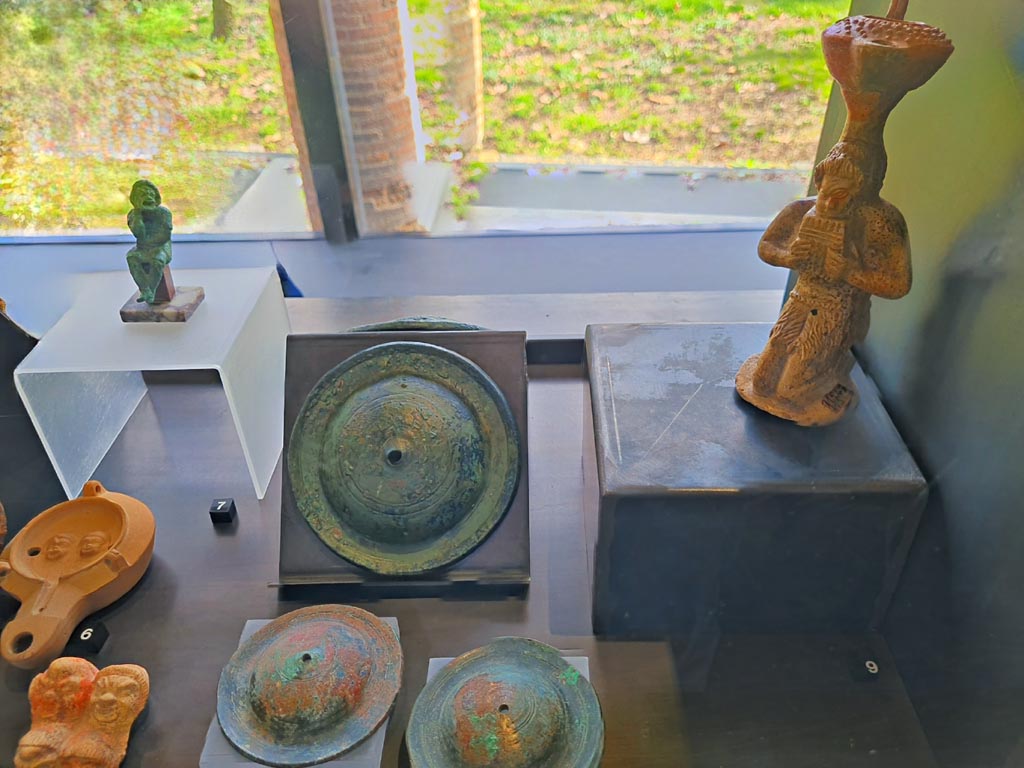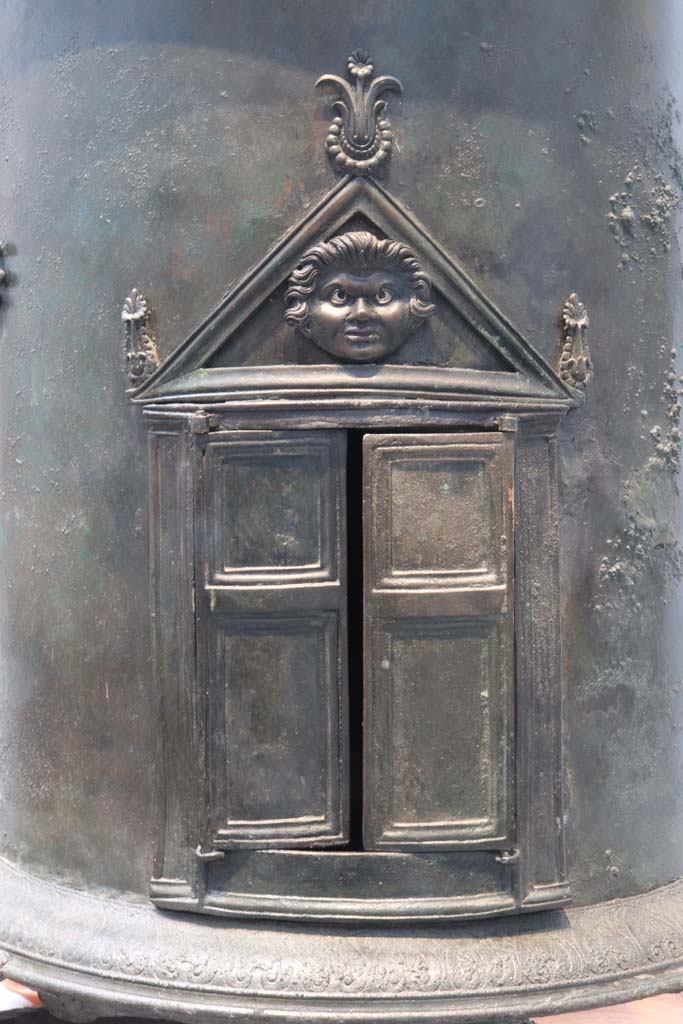I.8.17 Pompeii. Casa dei Quattro
Stili.
Linked to I.8.11. Excavated 1937/8 and 1951. Restored 1975-8.
Part: 1 2 3 4 5 6 7 8 9 10 11
Plan
Room 16

I.8.17 Pompeii. December 2021. Room 17, peristyle, looking
south along west portico. Photo courtesy of Johannes Eber.

I.8.17 Pompeii. December 2007. Room 17, peristyle, looking to south-east corner from near room 16.

I.8.17 Pompeii. 1959. Room 17, peristyle, looking south-east from near room 16. Photo by Stanley A. Jashemski.
Source: The Wilhelmina and Stanley A. Jashemski archive in the University of Maryland Library, Special Collections (See collection page) and made available under the Creative Commons Attribution-Non Commercial License v.4. See Licence and use details.
J59f0324

I.8.17 Pompeii. December 2007. Round puteal/vat in south-west corner of peristyle near room 16.

I.8.17 Pompeii. December 2007. Room 16. Room on south-west side of peristyle 17. Looking west through to atrium 3.

I.8.17 Pompeii. December 2007. Room 16. North wall to the west of the door.
Remains of a wall painting of Ariadne, Athena and Theseus?
See Bragantini, de Vos, Badoni, 1981. Pitture e Pavimenti di Pompei, Parte 1. Rome: ICCD. (p.87).
According to Peters, from the right upper corner a large portion of the stucco is missing.
Ariadne was sleeping, on the right. Theseus was standing near her but looking left towards Athena.
The yellow of Ariadne’s pillow and the carmine, yellow and green of the clothes form a vivid contrast to the sober surroundings.
See Peters, W.J.T. (1963): Landscape in Romano-Campanian Mural Paintings. The Netherlands, Van Gorcum & Comp. (p.99-100)

I.8.17 Pompeii. December 2007. Room 16, looking west into room 10 and through to atrium 3.

I.8.17 Pompeii. December 2007. Room 16, south wall, with remains of wall painting.
According to Peters, this painting was in a similar frame to the one on the north wall, within this were remnants of a landscape scene.
The landscape surroundings could no longer be interpreted.
See Peters, W.J.T. (1963): Landscape in Romano-Campanian Mural Paintings. The Netherlands, Van Gorcum & Comp. (p.100)
Room 17, peristyle

I.8.17 Pompeii. December 2007. Looking east along north side of peristyle 17 to rear entrance at I.8.11.

I.8.17 Pompeii. December 2007.
Room 17, peristyle garden. Looking south-east from the north end of the garden, towards rooms for kitchen and latrine.

I.8.17 Pompeii. December 2007. Looking north across garden 17.

I.8.17 Pompeii. December 2007. Room 17, peristyle, looking north-east.

I.8.17 Pompeii. December 2007. Looking north-west across garden 17 to rooms 18, 19 and staircase.

I.8.17 Pompeii. June 2010. Room 17, peristyle.
Looking south along west portico towards doorways of rooms 16, 11 and 18. Photo courtesy of Rick Bauer.
Room 18, exedra

I.8.17 Pompeii. May 2024. Room 18, exedra, looking west from
peristyle. Photo courtesy of Klaus
Heese.

I.8.17 Pompeii. December 2007. Looking west into Room 18, exedra in centre of west side of peristyle.

I.8.17 Pompeii. December 2007. Room 18, north wall of exedra.

I.8.17 Pompeii. October 2024. Room 18, exedra, looking
towards west wall. Photo courtesy of
Klaus Heese.

I.8.17 Pompeii. December 2021.
Room 18, looking towards west wall with
central painting of Pan and the nymphs.
Photo courtesy of Johannes Eber.

I.8.17 Pompeii. June 2010. Room 18, looking west. Photo courtesy of Rick Bauer.

I.8.17 Pompeii. December 2007. Room 18, west wall.

I.8.17 Pompeii. May 2024. Room 18, detail from upper west wall. Photo courtesy of Klaus Heese.


I.8.17 Pompeii. October 2024. Room 18, detail from upper west wall. Photo courtesy of Klaus Heese.

I.8.17 Pompeii. October 2024. Room 18, detail from upper centre of west wall. Photo courtesy of Klaus Heese.

Room 18, west wall with painting of Pan and the nymphs. Photo courtesy of Klaus Heese.

I.8.17 Pompeii. December 2007. Room 18, west wall, centre. Wall painting of Pan and the nymphs.
According to Peters, this painting was reassembled from fragments, and a few pieces in the centre are still missing.
The foreground was a stretch of water, in the centre was a tree with a column, against the tree a votive tablet had been placed.
Left of centre was a rock, two nymphs were sitting against the rock. They each held a jug, from which water was pouring.
Pan was standing on the flat ground to the right of centre.
See Peters, W.J.T. (1963): Landscape in Romano-Campanian Mural Paintings. The Netherlands, Van Gorcum & Comp. (p.89)

I.8.17 Pompeii. June 2010.
Room 18, west wall. Wall painting of Pan and the nymphs. Photo courtesy of Rick Bauer.

Room 18, west wall. Detail from painting of Pan and the nymphs. Photo courtesy of Klaus Heese.


I.8.17 Pompeii. December 2007. Room 17, peristyle, looking north along west portico towards room 20. Room 18 is on the left.
Room 19, small room or storeroom

I.8.17 Pompeii. December 2007. Room 19, small room or storeroom on west side of peristyle.

I.8.17 Pompeii. December 2007. Recess in room 19.
Staircase to upper floor next to room 19

I.8.17 Pompeii. December 2021.
Staircase to upper floor next to room 19. Photo
courtesy of Johannes Eber.

I.8.17 Pompeii. December 2007. Staircase to upper floor next to room 19.
Room 20, with remains of structures

I.8.17 Pompeii. June 2010. Looking west along the north side of peristyle 17 towards room 20. Photo courtesy of Rick Bauer.

I.8.17 Pompeii. December 2007. Room 20, room in north-west corner of peristyle. Looking west.

I.8.17 Pompeii. December 2007. Room 20, north wall with remains of structure.
Room 21, kitchen. Room 22, latrine. Room 23, decorated in the fourth style

I.8.17 Pompeii. December 2007. Room 17, peristyle garden.
Looking south-east from the north end of the garden, towards windows of rooms 23, 21 and 22. These rooms were not accessible.
According to P.P.M., room 23 is decorated in the fourth style, with white walls divided into panels bordered in red and with depictions of birds, a swan and panther.
Next to it is room 21, the kitchen, and next to that is room 22, the latrine.
See Carratelli,
G. P., 1990-2003. Pompei: Pitture e Mosaici: Vol. I.
Roma: Istituto della enciclopedia italiana, pp. 908-913.

I.8.17 Pompeii. December 2007. Looking north across garden 17 with the window to room 23 on right.
Finds

I.8.17 Pompeii. March 2024. No.7 – Bronze statuette of an actor
(top left) (1st century AD). Photo courtesy of Giuseppe Ciaramella.
On display in cabinet in exhibition in Palaestra
entitled – “L’altra Pompei, vite comuni all’ombra del Vesuvio”.
No.6 – Oil lamp with theatre masks (1st century AD), from I.9.9.
No.7 – Bronze statuette of an actor (1st century AD), from I.8.17.
No.8 – Bronze cymbals (1st century AD), provenance not known but from Pompeii.
No.9 - Oil lamp with Pan (1st century AD), from I.13.2.

I.8.17 Pompeii. March 2024. No.7 – Rear of bronze statuette of an actor (in centre) (1st century AD). Photo courtesy of Giuseppe Ciaramella.
Rear of cabinet, on display in exhibition in Palaestra entitled – “L’altra Pompei, vite comuni all’ombra del Vesuvio”.
On left, No.8 – Bronze cymbals from Pompeii.
On right, No.4 – one of two Terracotta theatre masks from Pompeii.

I.8.17 Pompeii. Coloured glass ointment jar found in the house. The lid is missing. Its height is 6cm.
SAP inventory number 7353.

I.8.17 Pompeii. Bronze cylindrical food warmer found in a made to measure niche under the stairs in the servants’ quarters.
It has a lid with three handles, one in the form of a statuette of Triton in the centre and two dolphins at the edges.
On the body are two handles in the form of hands, double doors at the front are surmounted by a pediment with palm leaves and a Medusa's head.
At the base, lion’s paw feet rest on three pillars connected by a double iron bar.
Now in Naples Archaeological Museum. Inventory number 6798.
See Conticello,
B., Ed, 1990. Rediscovering Pompeii. Rome: L’Erma di
Bretschneider, p. 173, no. 59.

VIII.1.4 Pompeii. February
2021.
Bronze cylindrical food warmer found under the
stairs in the servant’s quarters of I.8.17.
On display in Antiquarium. Photo courtesy of Fabien Bièvre-Perrin (CC BY-NC-SA).
The hollow cylinder of the latter rests on an iron tripod.
The feet are in the form of lion's paws, the handles end in small hands.
A small temple with a Gorgon in the tympanum can be seen in the opening.
Two dolphins and a Triton decorate the lid.
See Le Musée Maillol : Pompéi - Un art de
vivre, l’exposition du 21 septembre 2011 au 12 février 2012. Communiqué de
presse.
Parco Archeologico
Pompei, inventory number 6798.

I.8.17 Pompeii. February
2021. Detail from food warmer, on display in Antiquarium.
Photo courtesy of Fabien
Bièvre-Perrin (CC BY-NC-SA).

I.8.17 Pompeii. December
2019. Food warmer.
On display in exhibition “Pompei
e Santorini” in Rome, 2019. Photo courtesy of Giuseppe Ciaramella.

I.8.17 Pompeii. December
2019. Food warmer.
On display in exhibition “Pompei e Santorini” in
Rome, 2019. Photo courtesy of Giuseppe Ciaramella.

I.8.17 Pompeii. December
2019. Information card with food warmer.
On display in
exhibition “Pompei e Santorini” in Rome, 2019. Photo courtesy of
Giuseppe Ciaramella.
Part: 1 2 3 4 5 6 7 8 9 10 11
Plan